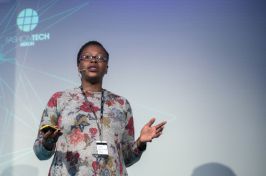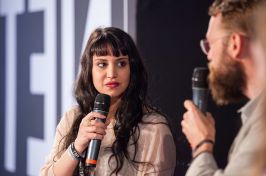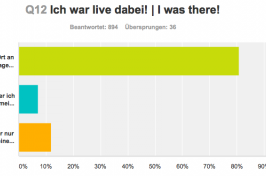It is often difficult to differentiate between information and propaganda, especially in war zones. Investigative journalist Aric Toler from Bellingcat offered tips on how to systematically verify data in "Open Secrets: Crowdsourcing Russia's Wars in Ukraine and Syria" on Day 2.
Aric Toler sees it as a game. "We follow up on all these hints" said the dark-haired young man with the black-rimmed glasses. He works for Bellingcat, an investigative research organisation. Together with his team, Toler verifies information all day, for example from the war zones in eastern Ukraine and Syria. Bellingcat researched two big projects which looked into where Russian tanks had been sighted in the Ukraine and where Russia had carried out airstrikes in Syria. It is especially hard to differentiate between what is actually information and what is propaganda in a war zone. Toler gave six tips on how to be able to verify the research despite these difficulties:
1. Archive your material
No matter the platform: It's important to immediately take screenshots of your material. This is because videos can easily be erased and reloaded later or pictures can be edited. One should clearly identify one's sources, says Toler, and make them easily accessible, meaning making them available as an open source. "That strengthens the trust between readers and journalists."
2. Geotagging
Lots of images that one finds on social media have geotags: Metadata that reveals where a picture has been taken. It also helps to take note of distinctive buildings, street signs or conspicuous features in the landscape to be able to identify locations.
3. Pay attention to details
"You have to pay attention to minute details" Toler said. When a Russian tank appeared in multiple videos, his team was able to identify it because of a tiny detail: a date that a bored soldier had scratched into the surface.
4. Use social media
Social media content is a valuable asset for research. For example, to find out where Russian tanks were stationed in the Ukraine, Aric Toler combed through the accounts of regular soldiers on social networks, because they especially liked to pose for selfies in front of tanks.
5. Propaganda as a source
Useful information can also come from those who spread the propaganda – if you categorize it critically. Toler came across a video from the Russian Ministry of Defence while researching the Russian military operation in Syria. It showed a Russian airstrike, supposedly on a Syrian oil refinery. But the shape of the targeted building was so out of the ordinary that Aric Toler's team soon found out: It was a civilian target, a water tank.
6. Let the crowd help you
Toler asked the community for help on CheckDesk, uploading material, for instance videos of unidentified tanks in the Ukraine. If anybody knew anything, they could comment on it. In one case, the decisive tip came from a person who recognized the same dent in a tank in two separate videos and was thereby able to identify the tank.
Anybody wishing to learn more on the topic of verification can inform themselves through the case examples on the Bellingcat page.
Image: re:publica/Gregor Fischer (CC BY 2.0)





